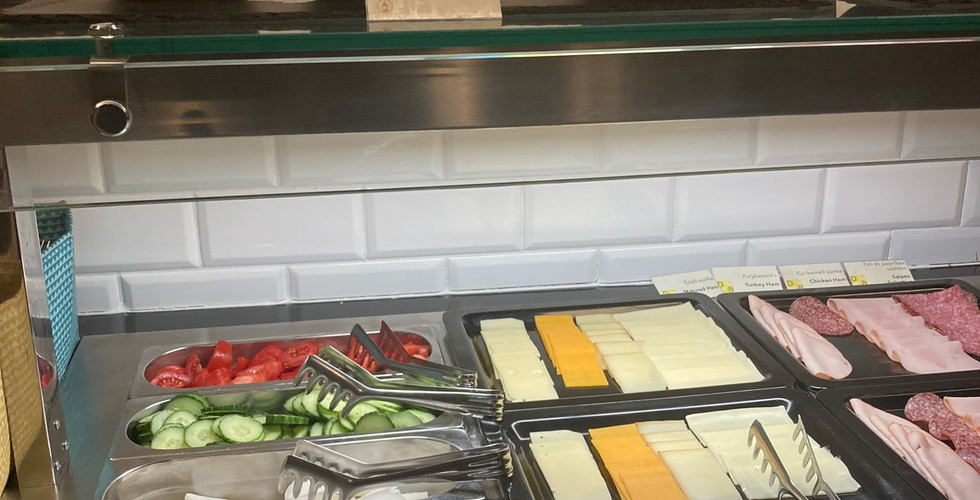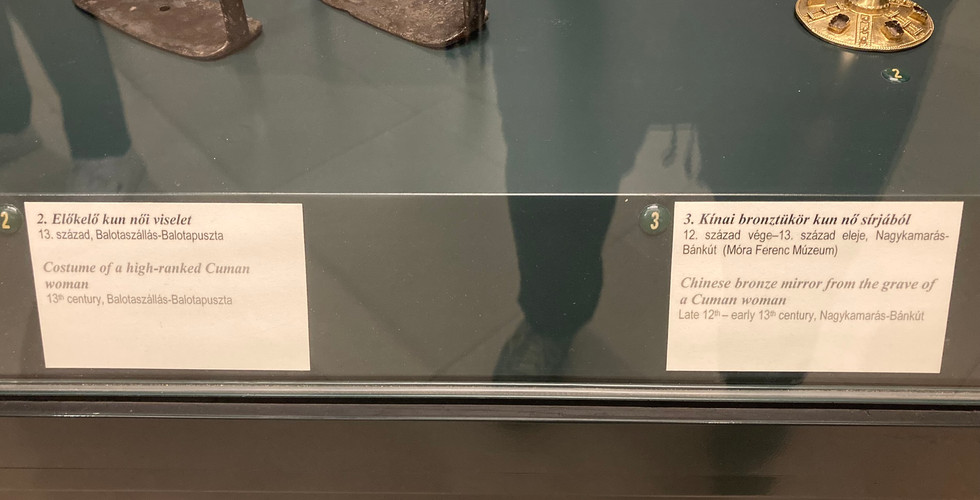Half-term Holidays Part 2: Budapest
- J Gill
- Nov 13, 2022
- 10 min read
Updated: Dec 3, 2022

It seems like I had a holiday where I was able to fulfil some long-time travel dreams. Hungary had been on my bucket list since high school, since becoming interested in the Austro-Hungarian Empire while studying WW1. I had been to Austria in 2001, and I needed only to get to the Hungary side, which I was finally able to do during this holiday. My husband happens to be part Hungarian and still has some relatives living in Budapest, so it made a trip there even more exciting for me because I'd have the opportunity to be more than a tourist and actually experience some interpersonal exchange that would allow me to learn more about Hungarian culture. For this post, I have decided to organise my trip experiences by topic rather than by what we did each day. I think it will better allow me to share my impressions overall for certain parts of the country and culture that I learned.
Food
One of my biggest food goals while I was there was to eat goulash. My dad had lived in Europe for a while before immigrating to Canada, and he used to rave about the delicious goulash he had while travelling in Hungary. I was able to try this on our first day out at a popular restaurant known for its traditional Hungarian fare, called Paprika. I absolutely loved it. It was as good as my dad boasted. It's not that I've never had it before; I have tried it in Canada, but it was always served as a standalone bowl of stew. Here, it was served with the traditional dumplings, which are like German Spaetzle, if you know what that is. It's a winning combination. The portion was huge, and although I was pretty full, I couldn't pass up the chance to also try traditional desserts, so I opted for a strudel filled with cottage cheese (more like a plain farmer's cheese) called túrós rétes and raspberry sauce. Again, just delicious. One odd thing we noticed while we were there is that we were surrounded by Chinese people. You'd think they were tourists, we learned that many Chinese people had moved to Budapest for work and have learned to speak the language and everything. So all these people were actual locals!
I was also able to try chicken paprikash (a chicken stew with lots of paprika) and langos (deep fried dough), but I didn't get to try them from places that were as well known for making good ones, so they were okay but not that exciting. It's not that we can't get langos at home, but usually they cater to local taste buds and put powdered sugar on it, whereas in Hungary, they are savoury with cheese and/or sour cream or garlic on top. So it's nice to try them as they are traditionally served if you get the chance. One thing I should mention about the traditional restaurant was that they had not only salt and pepper shakers, but one for paprika as well. I thought, only in Hungary!
At the hotel where we stayed, there were some interesting additions to the breakfast buffet that included red peppers (cone-shaped peppers, Latin name Capsicum annuum) and a variety of pickles. There was a sour cherry compote very similar to the one I used to make when I had an Evans cherry tree, and they had honey in little packets to go with your tea. I know that they have honey in North American hotels and breakfast restaurants, but it's usually in with the jams and is intended as a spread. In Budapest, these little honey packets were widely available for use with tea, and it was acacia honey, which has a mild flavour that I really enjoy. Anyway, it was interesting to see some of the differences with what appeals to local taste buds.
We also had the chance to try homemade cuisine. My husband's cousin had made these gingerbread honey cookies, Mézeskalács that were so delicious. I've similar cookies before, and I think there are similar ones made in a variety of European countries, and I've enjoyed them all. Before the country became communist, and businesses were nationalised, the ancestors of my husband's grandmother had owned one of the top companies for traditional honey cakes, and I guess their baking capabilities extend beyond the non-spiced versions. (I would add a link to the family as they would have been a household name at some point, but what information does exist hasn't been publicised, and perhaps much was lost under the Communist regime.) On our last night in Budapest, we ate again at our relative's place to try some traditional pancakes (we later discovered these are Hungarian style crepes), more cookies, and meatballs, vegetables (peppers and tomatoes), dinner rolls, and fruit (not necessarily in this order). It may have been a simple meal, but everything was so flavourful, and of course the company was excellent and allowed us to learn many things about Hungarian people, their attitudes and values, and about their lives in Hungary. The crepes were served with 3 different fillings, a homemade cottage/farmer's cheese that's sweetened and has raisins in it, grated smoked gruyere with sour cream, and homemade plum butter. All of them were delicious, but my favourite was the plum butter, and I hope I can learn to make it. It was a thoroughly enjoyable experience, and for me, eating should always be an experience whenever you can help it, not just something to be done mindlessly to keep the body going.
Places
We visited several places while we were there: the Ethnography Museum, St Stephen's Basilica, the Hungarian State Opera House, Central Market Hall, the Liberty Bridge, the National Museum of Hungary, and Buda Castle.
The Ethnography Museum sounded promising. We thought for sure there would be artefacts and anthropological perspectives on the people of the region, but it was mainly a museum of ceramics from around the world, some of which were not labelled. We learned that the museum is quite new, and we had the impression that it might have opened too soon as there were parts that were not yet open to the public, and we could see that some displays were still being constructed. Thankfully the museum is free, although they charge for exhibits, and I would question what you're getting if you pay for anything!
The basilica was one of the most beautiful I have come across and is very well preserved. They are probably able to help with upkeep because they charge for entry, which apparently wasn't the case when my husband had visited it 11 years ago, but the fee wasn't high and given the number of people visiting, they probably do get a lot of money to help keep the place in good shape. That includes restoring frescos and other paintings, of which there are quite a few. The basilica also houses the hand of St Stephen (a local saint, not to be confused with the Biblical one), and it used to be that you had to pay to see that, but now it's just part of the entry fee. I always find it odd that body parts are preserved and displayed to be worshipped and revered; I mean, does God really need provide more blessings through those than without them? Anyway, it's part of the experience, nonetheless.
I would have loved to see an opera at the Hungarian State Opera House, but all shows were sold out while we were there. We did at least get to have a tour of the building. It's quite stunning, and I was interested to learn that under the Austro-Hungarian Empire, the designer was told that it couldn't be as large as the opera house in Vienna, so it's a little smaller, and apparently when the Emperor saw it, he said he forgot to mention that the opera house was also not supposed to be more beautiful than the one in Vienna. Too late! So I was actually happy to have gone on this tour because I never got a chance to see the opera house inside in Vienna, and now I feel like I've seen the more beautiful one. A couple of interesting notes about it is that all the gold in the auditorium is real, but surprisingly only requires about 3kg of gold due to a style that somehow uses the gold in dust form rather than gold leaf. The room had also just been refurbished and had only re-opened this year, so we were lucky with timing to have got to see it as it could have been closed if we had visited Budapest earlier. The other interesting aspect was seeing the first balcony section for the royal family. Now that there is no more royal family, the area is no longer used (or allowed to be used) except on occasion by the Prime Minister and any of his guests. They have also made exceptions for some famous people such as Madonna. But given the setup, as you'll see in the photo, the seats are only good for the first 2 people as the rest have to sit behind and can't see the stage that well.

Our visit to Central Market Hall was mainly to do a little bit of shopping, but it was extremely crowded. It was difficult to move through the aisle because some parts were just jam-packed. We did stay long enough to buy a cushion cover with a traditional Hungarian embroidered pattern on it as I love that kind of stuff, but we decided to limit our stay as the crowds were just a bit overwhelming. We walked across nearby Liberty Bridge and just grabbed a few photos. The scenery was quite pretty, and there were fall colours to enjoy as well, contrasting beautifully against the green of the bridge.
At the National Museum, which has an impressive collection of artefacts, we learned a great deal more about Hungarian history. It's a complicated one of a people and nation conquered by different empires at different times. Prince Árpád was the first ruler of Hungary in the 9th Century, being a direct descendent of Attila the Hun, and the area later fell to the Mongols, the Ottoman Empire, the Austrian Empire (Habsburgs), and finally the Communists until they regained independence after the collapse of the Eastern bloc. It's an interesting history but requires much time to research all the invasions and changes in borders, and while there is much you can read at the museum, there were many displays with little to no information, so those parts could have been improved. One thing that really impressed me was the intricate designs of some of the gold work and jewellery. The craftsmanship is outstanding, and it's amazing how they have lasted all these centuries. Another interesting aspect was seeing a tiled stove, a common type of wood-/coal-burning stove that seem to be used in the area. My husband's relative actually had one in her home!
The visit to Buda Castle was a highlight of the trip. That it's up on a hill and surrounded by beautiful trees in fall colours allowed us to appreciate and enjoy panoramic views of the city from a few different vantage points. Inside the castle now are the national library and other types of places, so you don't really go in it but just walk around the grounds and enjoy the area. My favourite part of the grounds was St Matthias Church. The St Stephen's statue/monument is next to it, and it's a beautiful example of Gothic architecture but with a gorgeously colourful tiled roof. St Stephen himself is revered as the first Christian King of Hungary. We also got to see a small changing of the guard ceremony.
Around Town & General Impressions
It was great to walk around with family so that we could see different parts of the city we might not otherwise have seen, like general residential areas or even a cemetery where one of my husband's ancestors is buried in a mausoleum. We enjoyed riding the trams and metro, the latter being only a flight of stairs underground and really more resembles a tram than a proper subway; you even still get cell reception because you're just not deep enough to lose it. The trains are also short and look like the same cars have been used since at least the 60s, and there are even leather straps to hang onto if you're standing. It's rather quaint, but they seem sturdy enough, and if they still serve their purpose, why spend money on something newer? In various places, mostly in the cemetery, I noticed the Hungarian flag with a hole cut out in the centre. It turns out it was a sign of protest in the 1956 revolution as the Communist symbol in the middle of the flag would be cut out.
While walking around, we also came across the "Anonymous Writer" statue. No one knows who the statue is of, and the legend is that if you touch the statue, it will help make you a better writer. All I thought when I saw it is that it is terrifying and looks like the Grim Reaper.
It was misty a lot of the time we were there, so we didn't get great views of everything, but it made for some misty and mysterious looking photos. We had been hoping to go to their statue park where all the old Communist leaders have been re-located to, but there was no good way to get there by public transport, so we opted to focus our time on what we could easily get to (the public transportation system is quite good). One of the things that I think surprised me (though I shouldn't have been surprised, if I had taken time to think about it) is how much great architecture exists in the city centre. We often think only about the country as it existed during our lifetime--or at least I did--and about the Communist era and how everything would look so Soviet: utilitarian and grey, boxy buildings. The city has its fair share of those, but what we forget is that it had flourished, at least architecturally, under the Austro-Hungarian Empire and shares a lot of its ornate masonry to this period of time. There is also a Jewish Quarter with beautiful synagogues, one of which is built in Moorish style and has beautiful memorial in the form of a metal weeping willow tree in its yard, the names of Hungary's Jews killed in WW2 listed on the leaves of the tree.
As for the people, certainly the people I met there, they are a very proud people. They kept suggesting things for us to see and do, so much that we couldn't have time for it all, but you could tell that they really want to showcase the best of Hungary to us. They also mentioned the loss of territory and how Hungary is 2/3 the size it once was, and of the challenges faced under the Communist regime. They shared their thoughts on Hungary's economic and social issues and how they're embarrassed about the current government. My husband's cousin is also petitioning the government to try to create or find somewhere to house honey cake making history so that she can donate artefacts from her family's business to it. Her flat is like a tiny museum with all these interesting pieces, such as canisters the company produced as well as hand-carved moulds for the cakes. I hope she is successful. I always feel like these types of things shouldn't be forgotten.
I learned a lot and took in the experience as best I could. Hopefully we'll get the chance to go back and visit again, but I was very satisfied with our visit.











































































































































































































































































































































































Comments